Of the six offshore wind zones under development around Australia, the plans for wind turbines off the Illawarra coast have been by far the most contentious.
More than 14,000 people and organisations made submissions to the federal government’s public consultation on the proposed Illawarra offshore wind zone last year. The next highest was the consultation for the zone in the Southern Ocean off the coast of Victoria, with more than 3000 submissions.
Around Wollongong, it is not hard to find well-organised groups campaigning both for and against the offshore wind zone. So far, at least, it seems the naysayers are making the most noise.
Glenn Burgess, 71, from Towradgi, speaks for many when he asks: “Why can’t they put them off Sydney Heads?”
The Illawarra wind energy zone has been by far the most contentious of the off-shore wind-power proposals.Credit: Kate Geraghty
Yet conversations with people everywhere, from North Wollongong Beach to the main street of Port Kembla, paint a more nuanced picture: the community is sceptical but open to persuasion.
For every person who is vehemently opposed, we speak to another who is a stalwart supporter. Plenty of people say they do not know much about it yet. A common theme is that the person has seen some negative commentary and had some doubts, but they could be won over if the visual impacts were minimised, there were guarantees for local employment, and it could be proven that the impact on marine life was minimal.
Opposition Leader Peter Dutton continued with his nuclear strategy on Wednesday, announcing seven sites and at least one in every mainland state of Australia. People in Wollongong have their doubts about that, too.
But a policy from the opposition that may never happen is one thing, government action is another. Unlike nuclear power stations, the work to create an offshore wind zone industry started two years ago. Several zones have already been declared and are moving to project stage.
Most locals against the Illawarra wind zone commented that they thought most people were opposed. This ties in with new research from the University of Sydney, published in Ecology and Society, that suggests close-knit communities can harden their position on issues because of the reinforcing effect of the echo chamber. In this environment, genuine concerns are amplified, and misinformation can thrive – such as a fake journal article doing the rounds last year about the supposed effect of offshore wind on whale migration.
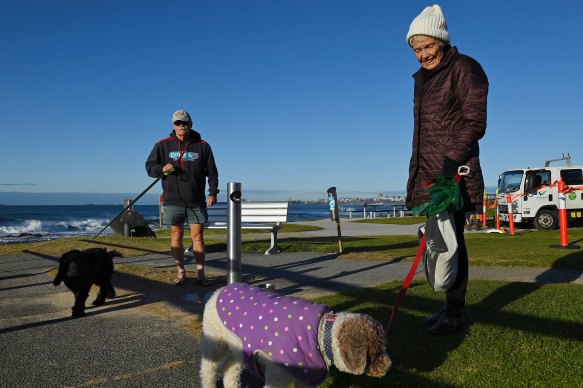
“Why couldn’t they put them off Sydney Heads”: Glenn Burgess and Nicky Maguire walking their dogs on Towradgi beach. Credit: Kate Geraghty
This is fertile ground for politicians. After Climate Change and Energy Minister Chris Bowen announced the Illawarra wind zone last weekend, Nationals leader David Littleproud visited a few days later, promising to overturn the two NSW wind zones in the Illawarra and the Hunter.
Two years ago, there was little to no offshore wind industry in Australia. The 15,000-kilometre zone off Gippsland is the biggest and also the first and most developed so far. It was approved in 2022, and feasibility licences have already been granted to proponents. The Hunter zone was declared last year, and the Southern Ocean and Illawarra zones this year. A zone in Bass Strait off Tasmania and another off the Bunbury coast in Western Australia are still under ministerial consideration.
The Illawarra zone is arguably the biggest test for the Albanese government so far because of the region’s population density. While the Hunter zone stretches past Newcastle, the second-biggest city in NSW, the Hunter declared area is 38 kilometres from Newcastle at the closest point. Proponents of wind farms in the Illawarra must ensure they are 20 kilometres out to sea – up from the original 10 kilometres.
Both sites were chosen because of their existing industrial base and proximity to transmission lines – unlike Sydney Heads.
Many Illawarra locals remain concerned about ruining the views of the beautiful coastline they love so much.
One of the groups opposed to offshore wind in the Illawarra, Responsible Future, has been handing out transparencies purporting to show what wind turbines would look like at 10, 20 or 30 kilometres offshore. A spokesperson for the group says the person needs to be one, two or three metres from the transparency for the visualisation to work, and it is usually distributed with instructions.
The aesthetic concern is top of mind for Madeleine Woods, 25, when we meet her working on her laptop after a run at North Wollongong beach. Woods moved to the area to enjoy the “serenity of the clear coastal views” only a year ago, and is disappointed that will be disrupted.
“If they are going to do it 20 kilometres out, surely they can do an extra 20 and make that a little bit further?” Woods says. “It makes me feel better that it’s not 10 kilometres out, but it’s still going to be completely visible.”
Woods is one of many beach users to mention the views, but not everyone shares the same perspective.
Shannon Sainty-Roach, 37, on the beach near Port Kembla’s Hill 60, says: “I’ve lived in Europe and seen wind farms, and they have a structural architectural beauty that, I tell you what, a coal mine will never have.”
Nicky Maguire, 78, out walking her dog near Towradgi beach north of Wollongong, doubts the wind turbines would be visible or noticeable at 20 kilometres offshore, based on her trips to Britain.
“It’s not a bad idea, I think it will create jobs, and they can’t talk about an eyesore when you’ve got the steelworks belching over there – I mean, really!” Maguire says. “So yeah, go for it. We’ve got to do something, and you can’t spend 10 years deciding where to do it and then change your mind.”
Also at Towradgi, longtime local Paul Lumby doubts the promise of local jobs.
“If the government signed on the bottom line that all the turbines, every component or installation is going to be done under Australian instruction, I wouldn’t be that mad about it,” Lumby says.
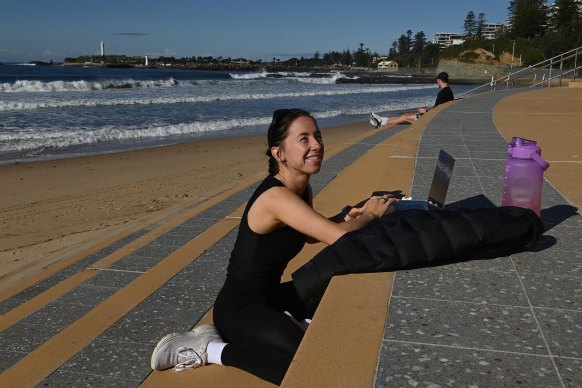
Madeline Woods is disappointed that her beach view is under threat.Credit: Kate Geraghty
In North Wollongong, Alex Pena is enjoying a morning coffee at the beach. Pena, who made a sea change moving from Sydney two years ago, says he supports moving away from fossil fuels, but he has concerns about the impact of offshore wind zones on a fragile environment and the views.
“I have misgivings more than anything else,” Pena says. “The move away from fossil fuels is very important, but my doubt or my concerns are that everything’s too rushed.”
Kelsie, 30, walking on North Wollongong beach with baby Olive, thinks the wind zone is a good option.
“The dangers that often get touted about effects to the bottom of the ocean and marine life, I think the dangers of global warming are a lot bigger, and there needs to be a solution,” says Kelsie, who requested her surname be withheld because of her job. “That might include something that we don’t necessarily love, but I think it’s the lesser of two evils.”
Later, as she meets a group of other young mothers for a baby’s birthday party, some of her friends share a different view.
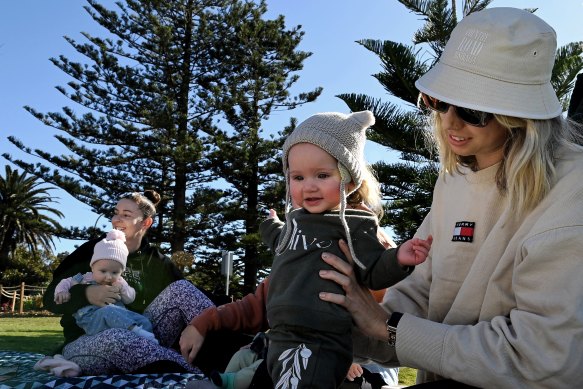
Belinda Melmoth (left) with her baby Ivy and Kelsie and baby Olive (right) with friends at a mothers group celebrating a birthday at North Wollongong beach.Credit: Kate Geraghty
Belinda Melmoth, with baby Ivy, says she has “a mixed view” on the wind farm, with concerns about marine life, aesthetics and possible health issues as she has heard that the harmonics of wind turbines can give people headaches.
“I would feel better if we started small rather than going the whole hog – like if they do a bit of a test,” Melmoth says.
Melmoth points out that her family members in the Illawarra are sceptical about the wind zone, while her family members in Sydney are in favour. “It’s easy to have opinions when it’s not going to be right in front of you every day,” she says.
The view from Port Kembla
People on the lovely but faded main street of Port Kembla are a bit less concerned about the views of the wind turbines, given they overlook the steelworks with its billowing smoke stacks. This is where the economic benefits of the project would be most felt. Yet, Port Kembla locals are as divided as everyone else.
At Burek on Wentworth in Port Kembla, owner Glenn McGregor, 50, says he is in favour of the wind zone. “If you can make power cheaper and create jobs, why wouldn’t you do it?”

Glenn McGregor, the owner of Burek on Wentworth, is backing the wind farm.Credit: Kate Geraghty
Across the road at the Shave Cave, hairdresser Martelle Jackson, 30, is keeping company with her friend Ella Dixon, 28, on a quiet day for the business.
Dixon says she has heard a lot of people are against it, including environmental groups, but she feels she needs to know more before having a firm opinion. “Whatever protects the ocean and the wildlife is what I’m about,” she says.
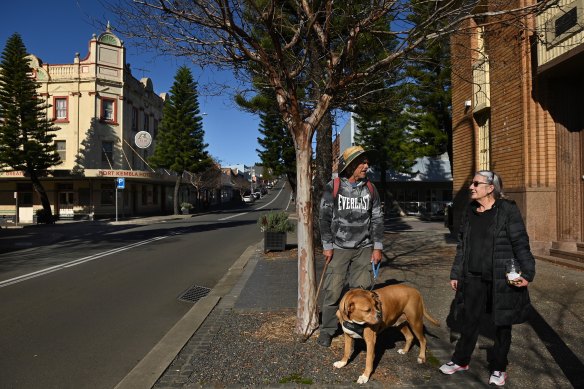
Eamonn Brunt, who is a climate change sceptic, talks with his friend and owner of the Port Kembla Laundrette Tracey Mackenzie.Credit: Kate Geraghty
Local surfer Eamonn Brunt, 66, stops with his dog for a treat at Port Kembla Laundrette, where the shopkeeper, Tracey Mackenzie, keeps dog treats.
Mackenzie, 62, is not sure what she thinks of the wind zone, but Brunt has firm views. “It’s a waste of money because we already have the infrastructure for oil and gas,” he says. “Climate change is a cult.”
When we meet Shannon Sainty-Roach, who lives in Farmborough Heights, she is taking two children, Kip, 2, and Finn, 1, to play on the beach north of Red Point near Port Kembla’s Hill 60.
Sainty-Roach says it is undeniable that the wind farms would have some impact, but she believes it is better than continuing to burn fossil fuels.
“Obviously, there are a lot of NIMBYs … but I believe in wind power 100 per cent, climate change is definitely real, and I’ve got little kids,” Sainty-Roach says.
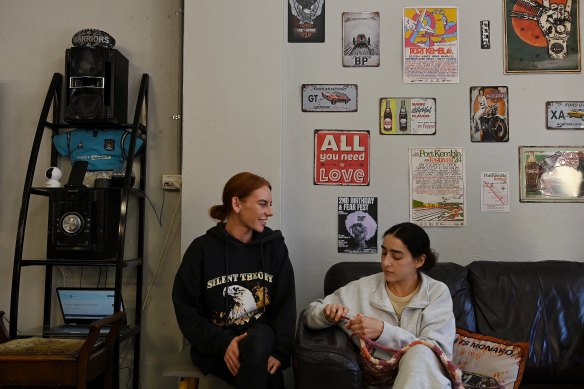
Martelle Jackson (left), the owner of The Shave Cave, with her friend Ella Dixon, who wants to know more before she makes up her mind about the wind farm.Credit: Kate Geraghty
“I think a lot of the opposition in Wollongong is pretty driven by right-wing stuff in social media because to be anti the wind farms when our escarpment is riddled with coal mines and the damage that they do in the water … these people just don’t know what they’re talking about, and I get very frustrated by it.”
Nearby at Red Point, Ali Mahmoud, 22, is fishing with his friend Sadiq.
A freshly minted citizen who is mostly commuting to Sydney for work, he is enthusiastic about the zone for the prospect of moving away from coal and delivering cheaper energy. “That’s going to be great – renewable energy!” he exclaims. “That’s going to power all of Illawarra, maybe.”
What about the nuclear option?
Dutton announced the seven nuclear sites on the same day as our visit to Wollongong, and views were pretty mixed on this as well.
Neither pro-wind Maguire nor anti-wind Burgess, who were walking their dogs together near Towradgi beach, wanted nuclear.
“You’ve only got to look at what happened in Japan,” Burgess says. “They’ll probably be built on the coastline if they build them. It might be clean, but it’s just the repercussions of what can happen with nuclear.”
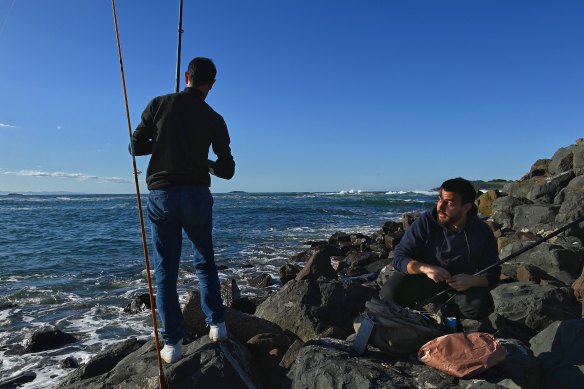
Ali Mahmoud is enthusiastic about the wind farm.Credit: Kate Geraghty
North Wollongong mother Belinda Melmoth, with baby Ivy, pointed out she already lives near the Australian Nuclear Science and Technology Organisation in Lucas Heights. But having visited Hiroshima recently, she wonders if nuclear power stations could be targets in the event of war.
Her friend Emily Mierendorff, with baby Clara, likes the idea of nuclear: “It’s just a question of where to put the waste, but lots of countries do it.”
At Port Kembla, pro-wind McGregor says: “I don’t want a nuclear reactor sitting there, I’ve got kids. [In a war] what’s the first thing that happens? They go ‘OK, you’ve got a nuclear substation in Port Kembla, how about we blow it up first?’”
Pro-renewables Sainty-Roach says she is not “straight-up opposed to nuclear power”, but she thinks there are better options.
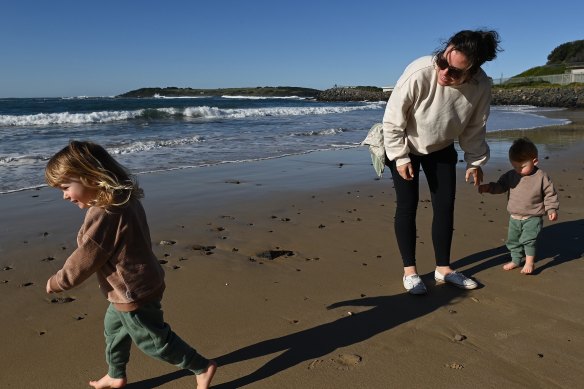
Shannon Sainty-Roach with her children Kip and Finn at Fishermans Beach, Port Kembla.Credit: Kate Geraghty
Pena at North Wollongong Beach says he would prefer to pursue the nuclear option than go further down the wind path.
“I think it should go ahead,” he says. “I think that’s a viable option that’s tested elsewhere. I think this country can support it and has the infrastructure to do it.”
Woods, who was concerned about being able to see the wind turbines at North Wollongong beach, says she does not mind nuclear if it is not near her.
“It sounds horrible, but ignorance is bliss for me, if I can’t see it,” she says. “I just want to come here for some peace.”
Get to the heart of what’s happening with climate change and the environment. Sign up for our fortnightly Environment newsletter.

